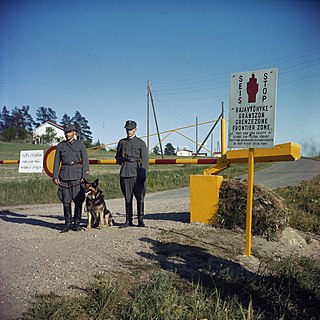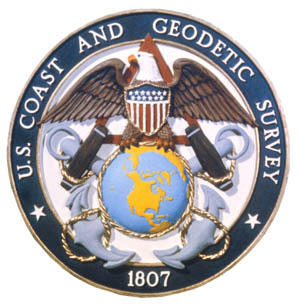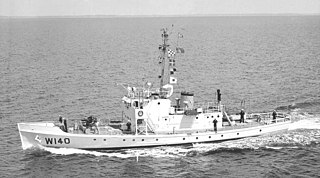
The United States Coast Guard (USCG) is the maritime security, search and rescue, and law enforcement service branch of the United States Armed Forces and one of the country's eight uniformed services. The service is a maritime, military, multi-mission service unique among the United States military branches for having a maritime law enforcement mission with jurisdiction in both domestic and international waters and a federal regulatory agency mission as part of its duties. It is the largest coast guard in the world, rivaling the capabilities and size of most navies.

The Posse Comitatus Act is a United States federal law signed on June 18, 1878, by President Rutherford B. Hayes that limits the powers of the federal government in the use of federal military personnel to enforce domestic policies within the United States. Congress passed the Act as an amendment to an army appropriation bill following the end of Reconstruction and updated it in 1956, 1981 and 2021.

A coast guard or coastguard is a maritime security organization of a particular country. The term embraces wide range of responsibilities in different countries, from being a heavily armed military force with customs and security duties to being a volunteer organization tasked with search and rescue without law enforcement authority. In most countries, a typical coast guard's functions are distinct from those of the navy and the transit police, while in certain countries they have similarities to both.
The United States has eight federal uniformed services that commission officers as defined by Title 10 and subsequently structured and organized by Titles 10, 14, 32, 33, and 42 of the U.S. Code.

The United States Revenue Cutter Service was established by an act of Congress on 4 August 1790 as the Revenue-Marine upon the recommendation of Secretary of the Treasury Alexander Hamilton to serve as an armed customs enforcement service. As time passed, the service gradually gained missions either voluntarily or by legislation, including those of a military nature. It was generally referred to as the Revenue-Marine until 31 July 1894, when it was officially renamed the Revenue Cutter Service. The Revenue Cutter Service operated under the authority of the U.S. Department of the Treasury. On 28 January 1915, the service was merged by an act of Congress with the United States Life-Saving Service to form the United States Coast Guard.

The Rum Patrol was an operation of the United States Coast Guard to interdict liquor smuggling vessels, known as "rum runners" in order to enforce prohibition in American waters. On 18 December 1917, the 18th Amendment to the Constitution was submitted to the states by Congress. On 16 January 1919, the amendment was ratified and the Liquor Prohibition Amendment, which prohibited the manufacture, sale, transportation, importation, or exportation of intoxicating liquors, came into effect on 16 January 1920.

USS Beale (DD-40), a Paulding-class destroyer served in the United States Navy during World War I and later with the United States Coast Guard. She was the first ship of the Navy to be named for Edward Fitzgerald Beale.

The Indian Coast Guard (ICG) is a maritime law enforcement and search and rescue agency of India with jurisdiction over its territorial waters including its contiguous zone and exclusive economic zone. It was started on 1 February 1977 and formally established on 18 August 1978 by the Coast Guard Act, 1978 of the Parliament of India. It operates under the Ministry of Defence.

Frederick Chamberlayne Billard served as the sixth commandant of the United States Coast Guard for an unprecedented three terms from 1924 until his death in 1932. Rear Admiral Billard died of pneumonia in May 1932 shortly after starting his third term. There were major changes to the organization during his career. The U.S. Revenue-Marine that was established on 4 August 1790 became the Revenue Cutter Service in 1894, the same year he enlisted. The Revenue Cutter Service that he had entered in 1894 merged with the United States Life-Saving Service to form the United States Coast Guard on 28 January 1915.

Ellsworth Price Bertholf was a Congressional Gold Medal recipient who later served as the fourth Captain-Commandant of the United States Revenue Cutter Service and because of the change in the name of the agency in 1915, the fourth Commandant of the United States Coast Guard. His leadership during his tenure as Commandant was critical to the U.S. Coast Guard's survival at a time when outside agencies wanted to either take it over or split its missions up among several agencies.

A border guard of a country is a national security agency that ensures border security. Some of the national border guard agencies also perform coast guard and rescue service duties.

The ensign of the United States is the flag of the United States when worn as an ensign. International maritime law—see International Treaty on Law of the Sea, articles 91 and 92—provides that vessels have a "national character" and thus should display a flag (ensign) that corresponds to this national character, especially when in international or foreign waters. Vessels that are formally documented under the federal vessel documentation act, vessels owned by government bodies in the United States, and vessels in the U.S. military unquestionably have U.S. national character, and thus properly hoist a U.S. ensign to show their national character. Vessels that are numbered by the states and small, non-registered craft owned by U.S. citizens and not registered in other countries may also hoist a U.S. ensign to show their national character.

USRC Windom was a revenue cutter of the United States Revenue Cutter Service and United States Coast Guard that served from 1896 to 1930. She was named for William Windom, the 33rd and 39th United States Secretary of the Treasury. She served during the Spanish–American War with the United States Navy. Windom was recommissioned as USCGC Comanche in 1915 and again served with the Navy as USS Comanche during World War I.
The history of the United States Coast Guard goes back to the United States Revenue Cutter Service, which was founded on 4 August 1790 as part of the Department of the Treasury. The Revenue Cutter Service and the United States Life-Saving Service were merged to become the Coast Guard per 14 U.S.C. § 1 which states: "The Coast Guard as established January 28, 1915, shall be a military service and a branch of the armed forces of the United States at all times." In 1939 the United States Lighthouse Service was merged into the Coast Guard. The Coast Guard itself was moved to the Department of Transportation in 1967, and on 1 March 2003 it became part of the Department of Homeland Security. However, under 14 U.S.C. § 3 as amended by section 211 of the Coast Guard and Maritime Transportation Act of 2006, upon the declaration of war and when Congress so directs in the declaration, or when the president directs, the Coast Guard operates as a service in the Department of the Navy.

United States Naval Districts is a system created by the United States Navy to organize military facilities, numbered sequentially by geographic region, for the operational and administrative control of naval bases and shore commands in the United States and around the world. Established in 1903, naval districts became the foundational system for organizing U.S. naval forces ashore during the 20th century. The term "Naval" forces includes United States Marine Corps and current United States Coast Guard units.

The United States Coast and Geodetic Survey was the first scientific agency of the United States Government. It existed from 1807 to 1970, and throughout its history was responsible for mapping and charting the coast of the United States, and later the coasts of U.S. territories. In 1871, it gained the additional responsibility of surveying the interior of the United States and geodesy became a more important part of its work, leading to it being renamed the U.S. Coast and Geodetic Survey in 1878.

USCGC Crawford (WSC-134), was a 125 ft (38 m) United States Coast Guard Active-class patrol boat in commission from 1927 to 1947. She was named for William H. Crawford, (1772–1834) who was appointed in 1816 as Secretary of the Treasury by President James Madison and he continued under President James Monroe through 1825. Crawford was the seventh vessel commissioned by the U.S. Revenue Cutter Service and the Coast Guard named after the former secretary. She served during the Rum Patrol and World War II performing defense, law enforcement, ice patrol, and search and rescue missions.

USCGC Unalga (WPG-53) was a Miami-class cutter that served in the United States Revenue Cutter Service and later the U.S. Coast Guard and U.S. Navy. The early part of her career was spent patrolling the Pacific coast of the United States and the Bering Sea. After 1931 she did patrol work off Florida and in the Caribbean. After Unalga was sold in 1946, she was renamed after Jewish Agency leader Haim Arlosoroff and used for six months for moving Jewish refugees from Europe to Palestine before being forced to run aground by British Navy ships near Haifa.

The Howard Coble Coast Guard and Maritime Transportation Act of 2014 is a statute of the United States that governs the activities of the United States Coast Guard (USCG), the Maritime Administration (MARAD) within the Department of Transportation, and the Federal Maritime Commission (FMC). The bill also would authorize appropriations totaling about $17.5 billion, primarily for ongoing USCG operations over the 2015-2016 period.

















